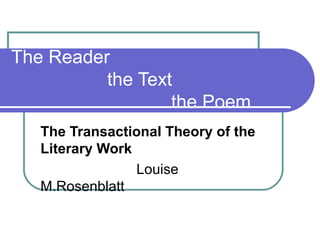
Evoking the poem2
- 1. The Reader the Text the Poem The Transactional Theory of the Literary Work Louise M.Rosenblatt
- 2. CHAPTER 4: EVOKING A POEM Rosenblatt sketches some of the major process involved in evoking the work from the text. There are different functions readers go through as they read the text and how this activities influence their response to literature.
- 3. CHAPTER 4: EVOKING A POEM Through conscious and unconscious choice, the reader uses the verbal clues given by the author ( diction, setting, character development) along with personal circumstance and experience, to form his or her response to the work. Through these activities, the reader becomes part of the creative process along with the author.
- 4. CHAPTER 4: EVOKING A POEM Through the reader’s evocation and interpretation of a poem, actually has the power to change the text. Different readers have “decidedly diverse personal responses which become woven into the texture of the experienced poem” (p. 65)
- 5. CHAPTER 4: EVOKING A POEM The author gives the examples of a reader’s cultural background, personal experience and literary knowledge as elements which can dramatically change a piece of literature for that reader. There are no “wrong” response because reader response is always the reader response. It is built out of logic and experience of the reader.
- 6. CHAPTER 4: EVOKING A POEM So, teachers must not set boundaries for interpretation of the text instead give the students the freedom to be part of the creative process and respond to the text according their personal experience.
- 7. CHAPTER 4: EVOKING A POEM Explains that the experience of evoking the poem goes on as the reader gets further into the works. The term poem here refers to the artistic creation that the reader constructs while reading a literary work. (Rosenblatt is not discussing only poetry here but any artistic work of literature)
- 8. CHAPTER 4: EVOKING A POEM The reader “is immersed in a creative process that goes on largely below the threshold of awareness” (p.52). This process “imposes the delicate task of sorting the relevant from the irrelevant in a continuing process of selection, revision and expansion: (p.53)
- 9. P.54 As one decodes the opening lines or sentences and pages of a text, one begins to develop a tentative sense of a framework within which to place what will follow. Underlying this is the assumption that this body of words, set forth in certain patterns and sequences on the page, bears the potentiality for a reasonably unified or integrated, or at the very least coherent, experience.
- 10. P.54 One evolves certain expectations about the diction, the subject, the ideas, the themes, the kind of text, that will signal certain possibilities and exclude others, thus limiting the arc of expectations. What the reader has elicited form the text up to any point generates a receptivity to certain kinds of ideas, overtones, or attitudes.
- 11. P. 54 Perhaps one can think of this as an alerting certain areas of memory, a stirring-up of certain reservoirs of experience, knowledge, and feeling. As the reading proceeds, attention will be fixed on the reverberations of implications that result from fulfillment or frustration of those expectations.
- 12. CHAPTER 4: EVOKING A POEM This process itself is part of the appeal of reading a work of literature. P.54-55
- 13. CAPTER 4: EVOKING A POEM One potential objection to the reader-response theory of literary criticism is that it suggests that anyone’s reading of a work is just as valid as any other reading. Some readings are more informed than others and that people can become better readers through practice and experience:
- 14. Extract from the book: Past literary experiences serve as subliminal guides as to anticipated, the details to be attended to, the kinds of organizing patterns to be evolved. (p.57) Traditional subjects, themes, treatments, may provide the guides to organization and the background against which to recognize something new or original in the text. (p.57)
- 15. Extract from the book: Awareness-more or less explicit-of repetitions, echoes, resonances, repercussions, linkages, cumulative effects, contrasts, of surprises is the mnemonic matrix for the structuring of emotion, idea, situation, character, plotin short, for the evocation of a work of art. (p.58)
- 16. CHAPTER 4: EVOKING THE POEM For the experienced reader, much of this has become automatic, carried on through a continuing flow of responses, syntheses, readjustment and assimilation. The reader’s reading process allows “compatible associations into the focus of attention. (p.60)
- 17. TO SUMMARIZE: 2 streams of responses involved in any reading event: # evocation # interpretation Cannot be separated.
- 18. TO SUMMARIZE: Rosenblatt argues “the range of potential responses and the gamut of degrees of intensity and articulateness are infinitely vast, since they depend not only on the character of the text but even more on the special character of the individual reader” (p.49)
- 19. TO SUMMARIZE: The readers’ role in evoking and interpreting the poem can be quite complex. The text’s involvement in this process is of equal importance
- 20. TO SUMMARIZE: Each genre makes different demands of a reader. New meaning arrives on the scene concerning the expectation the reader has of each particular work. Brings to work past associations and experiences
- 21. THE END Presented by: AZLINDA ZAFIRAH BINTI ASHAARY AFIQAH AMANINA NOOR HARMIMI BT ABDUL HALIM
